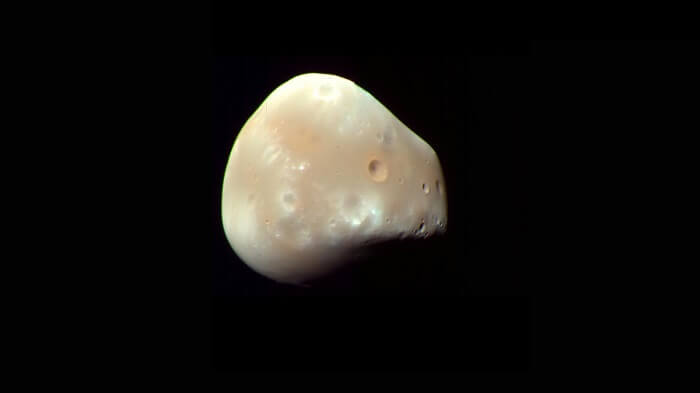What is Deimos? What are the characteristics of Deimos, one of the moons of Mars? The structure of Deimos, interesting information about Deimos.

Deimos
Deimos is one of the two small natural satellites of the planet Mars. It is the smaller of the two and was discovered by Asaph Hall in 1877. The name “Deimos” is Greek for “terror” or “dread”, which is fitting as it was named after the sons of Ares, the Greek god of war, who were Deimos and Phobos. Deimos is irregularly shaped, and its surface is heavily cratered and covered in a layer of fine dust. Its surface is also very dark, with a low albedo (reflectivity), and it has a reddish color due to the presence of iron oxide. It is also known that Deimos has a small amount of water-ice on its surface, which was discovered by the Mars Express spacecraft in 2009. The surface of Deimos is also thought to be covered in a layer of fine dust, which is constantly being replenished by impacts from micrometeoroids. The mean radius of Deimos is about 6.2 km, and its average distance from Mars is about 23,460 km.
Deimos has been studied by a number of spacecraft, including the Viking orbiters, the Mars Reconnaissance Orbiter, and the Mars Express. These missions have provided detailed images and data on the satellite’s surface, composition, and geology. Scientists are also interested in studying Deimos as a potential destination for future manned missions to Mars. The study of Deimos can help us understand the geology of Mars, the history of its satellite system, and the conditions that may have existed on the Martian surface in the past.
Characteristics
Deimos is one of the two small natural satellites of Mars, the other being Phobos. It is the smaller of the two, with a mean radius of about 6.2 km and an average distance from Mars of about 23,460 km. It has an orbital period of about 30.3 hours, meaning it takes about 30.3 hours for Deimos to orbit Mars once.
Deimos has a heavily cratered surface that is covered in a layer of fine dust. The craters on its surface range in size from small impact craters to large basins that are up to 20 km in diameter. The surface of Deimos is also very dark, with a low albedo (reflectivity) of about 0.07. This is due to the presence of iron oxide on its surface, which gives it a reddish color.
Deimos also has a small amount of water-ice on its surface, which was discovered by the Mars Express spacecraft in 2009. The surface of Deimos is also thought to be covered in a layer of fine dust, which is constantly being replenished by impacts from micrometeoroids.
Deimos is also considered as a potential destination for future manned missions to Mars, as it is relatively small and its surface is thought to be relatively stable and safe for landing. It could serve as a valuable resource for scientists, as it could contain information about the history of Mars and the conditions that existed on the planet in the past.
The characteristics of Deimos are:
- Irregularly shaped, heavily cratered and covered in a layer of fine dust.
- Its surface is also very dark, with a low albedo (reflectivity), and it has a reddish color due to the presence of iron oxide.
- It has a small amount of water-ice on its surface.
- The mean radius of Deimos is about 6.2 km, and its average distance from Mars is about 23,460 km.
- Has been studied by a number of spacecraft, including the Viking orbiters, the Mars Reconnaissance Orbiter, and the Mars Express.